This book provides both a nostalgic look at the years 1957 to 1963 on the West Coast Main Lines, and the history of the line from the days of the London and Northwestern Railway.
Published in June 2022 by Pen & Sword and written by John Palmer, this hardback book measures around 17.1 cm x 24.8 cm, has 288 pages and 35 colour & 100 black and white illustrations, maps & diagrams. It has a published price of £35, although at the time of writing Pen & Sword has it available online for £26.25 and it can be obtained from Amazon for £24.53.
With 11 chapters, this book is an outstanding example of a description of the West Coast Main Lines during the years when the use of steam locomotives on the line was in decline in the wake of dieselisation and partial electrification.
Chapter 1 ‘Origins and Characteristics’ provides a history of the route from the formation of the London and Northwestern Railway in 1846, and includes copious maps and gradient profiles. Chapter 2, ‘Setting the Scene’ describes the state of the railways, and particularly the London Midland Region, just prior to the years covered by the book.
Chapters 3 to 10 describe the services that operated each year from 1957 to 1963, and the changes that happened from one year to the next. Chapter 11 will be familiar to all rail enthusiasts with the title of “You’ll’ Never Believe What’s Been Through”, recalling the days when unusual locomotive sightings were something that stirred excitement in all trainspotters.
The amount of details in the six Appendices is staggering, with Appendix 1 listing extracts from working timetables, Appendix 2 lists weekday main line departures from London Euston in 1898 and 1908, Appendix 3, lists weekday main line departures in winter from London Euston in 1935 and 1956, Appendix 4, lists locomotives designed for the LMS by Sir William Stanier, Appendix 5, details visits to and times in Crewe Works by Princess Coronation and Princess Royal Class locomotives between 1957 and 1959, and Appendix 6, lists main line passengers trains passing through Preston, Chester General, and Tamworth Low Level on summer Saturdays in 1960.
A well-written narrative describes the history of the route, its physical characteristics and its passenger and freight traffic. It brings to life why the route was such an attraction to the hordes of young trainspotters and other observers who thronged the lineside to view processions of trains hauled by magnificent express passenger locomotives.
The book also goes behind the scenes to show the challenges of the day-to-day management of that section of the railway network and its seasonal peaks. For anyone who remembers these years the book provides vivid memories of the railways in those times. The many photographs, excellent history, and well-written text are enhanced by the superb quality of the printed book.
The book is remarkable for having 24 maps, some of them large-scale such as on the left below, but there are also large-scale maps showing more detailed information of 11 locations such as the one of the Glasgow area on the right. Other large-scale maps show the West Midlands, Manchester area, Liverpool Lime Street and the surrounding area, Rugby, Carlisle, Crewe, Preston and Blackpool, Chester, and Tamworth.
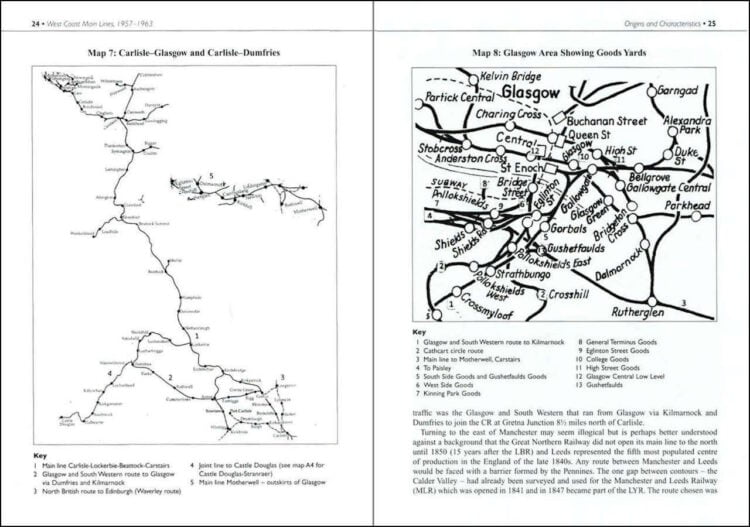
Of particular interest are a number of gradient profiles that provide a clear illustration of the challenges of working the major inclines on the route, such as the profile from Beattock station to Beattock summit shown at the top-right below. The photograph on the left illustrates the smoke effects to be seen when steam locomotives were working hard on these gradients.
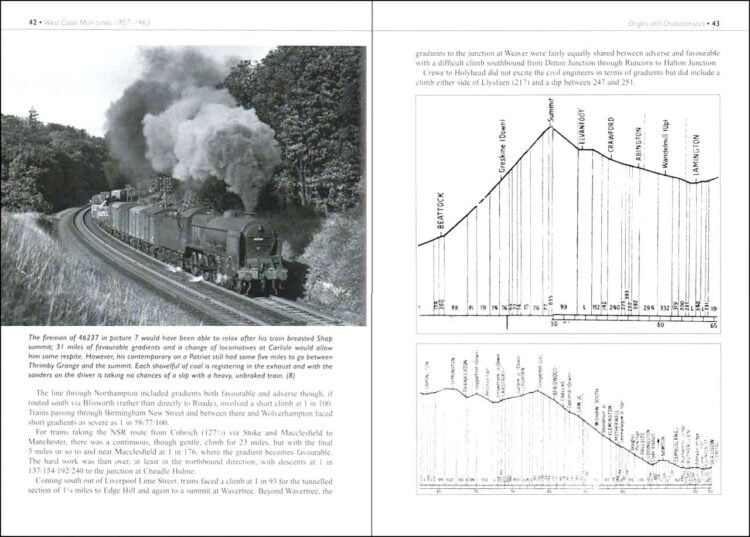
Providing a great contrast with the later express locomotives seen on the West Coast Main Line are the early examples of London and Northwestern Railway locomotives below. The Claughton class seen on the right below were one of the mainstays of the West Coast Main Line immediately before the Grouping in 1923 when the line became part of the London, Midland and Scottish Railway.
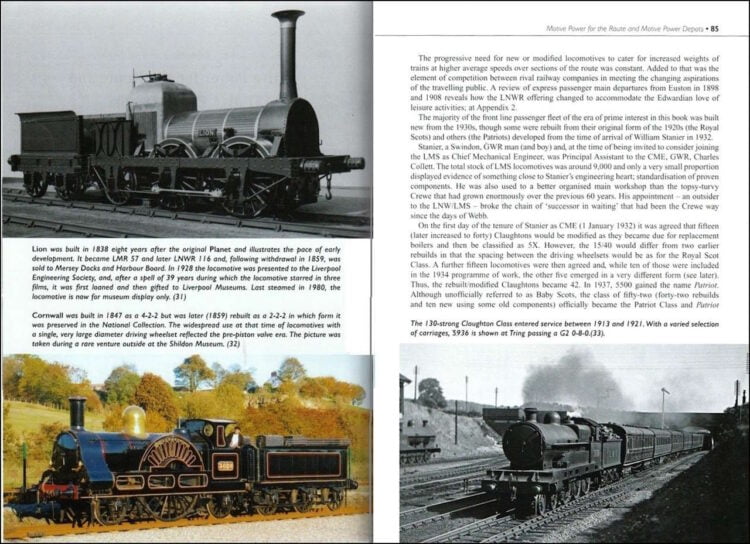
Standing out for their performance leading up to the demise of steam on the the West Coast Main Line are William Stanier’s Coronation Pacifics, exemplified by No. 46222 Queen Mary on the left below, which has been relieved of its duties at Carlisle after bringing the “Royal Scot” from Glasgow, and still carries the “Royal Scot’s” unique headboard. Also plain to see on the pages below is the extensive narrative that is a feature of the book.
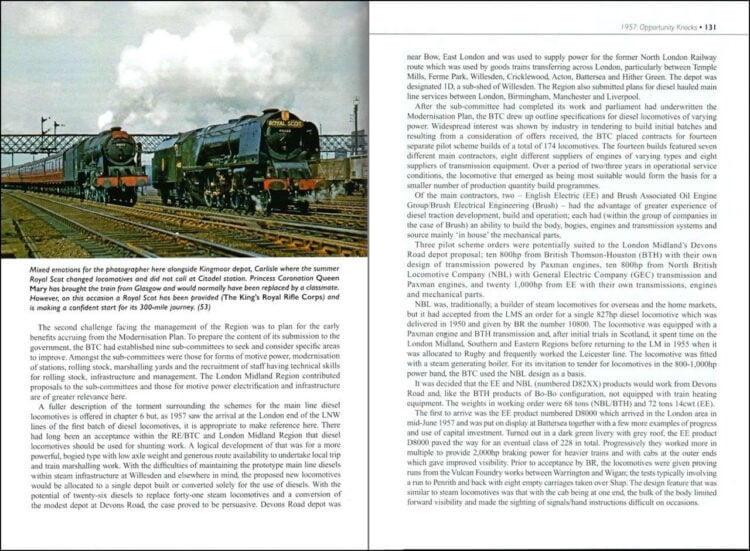
Throughout the book the author has included many useful tables to explain details, such as the upper one on the right below that shows where surviving members of the Princess Royal and Princess Coronation classes were allocated in August 1962. The lower table illustrates the declining use of Princess Coronation Class Pacifics by November 1962, although I suspect the entry for 36 November is an obvious typing error.
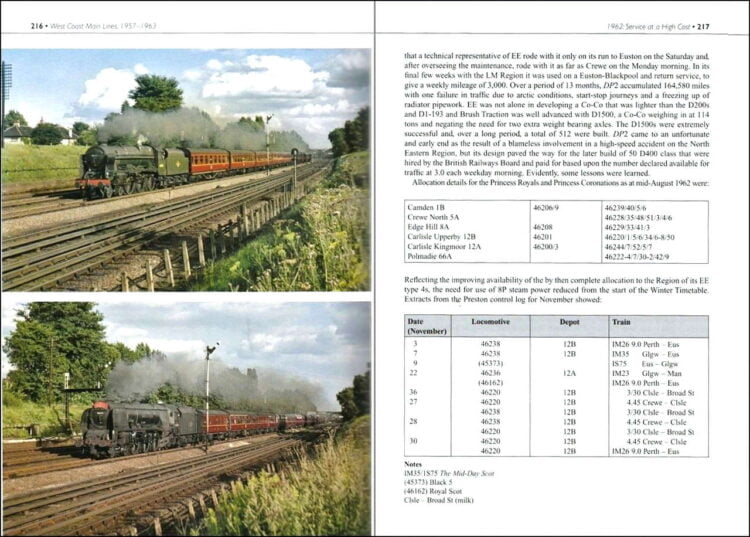
This book is an eminently-readable volume throughout its 11 chapters. At no time does the story drag, and each page flows with a well-written narrative. The inclusion of a chapter on the origins and characteristics of the route with its maps and gradient profile, and a chapter that describes the state of the railways leading up to the years covered by the book provides a useful introduction to the subject years of 1957 to 1963.
The dramatic changes that happened from one year to the next are sometimes eye-opening and explained in detail, while the final chapter will bring back many memories to all trainspotters who were around in those years..
The author is to be congratulated for his research in producing the amount of details in the six Appendices, and they are an excellent supplement to the book, rather than as an add-on at the end.
The large number of maps must rank as one of the best selection to be found for a book of this nature.
From the very first page the narrative flows and never gets bogged down in technical details, while the many tables provide useful supplements to the text. This is a book for anyone who is interested in the last years of steam on the West Coast Main Lines, not only for those were there at the time, but for anyone who wishes to revel in the nostalgia of how the railway operated in those days..
A detailed index is a valuable addition.
The book is available to purchase from Amazon and from Pen & Sword.
We would like to thank Pen & Sword for providing RailAdvent with a copy of the book for review.






Responses